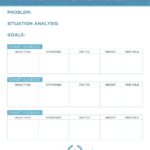Looking for our “2025 PR Planning” worksheet? Scroll down to download it now!
The beginning of the year isn’t just a good time to set goals in your personal life — it can also be a valuable opportunity to refocus on your organization’s public relations plans and ensure the efforts you’re undertaking will set you up for success all year long.
The best way to develop public relations plans is to follow the four-step RPIE method, which will help you critically think through all of the communication activities that are part of your campaign and ensure they connect to the broader goals of your organization.
Whether you’re a novice public relations pro who is new to the world of RPIE or an experienced communicator who just needs a little refresher, here are the key things you need to know about this four-step method to PR success:
Step #1: Research
While the term “public relations” often conjures images of large events like black-tie galas and fun social media campaigns, those working in the field know the reality: a substantial part of any PR pro’s life is actually spent deep-diving into data. Before you can start flexing your creative muscles to plan a successful PR campaign, you have to do the research and carefully consider questions such as:
- WHO are you trying to reach with the campaign?
- WHAT do we want the audiences we reach to do?
- WHAT are the key messages we want the audiences who engage with our communications activities to take away?
It’s not enough to just use your intuition to answer these questions with what you feel is right (in fact, many PR pros will tell you that proper research is almost guaranteed to lead to some surprising findings and new insights!). Instead, you must engage in primary research (think focus groups, surveys, and interviews) and secondary research (think Internet/social media research, literature reviews, and fact-finding) in order to find real data that will help you back up your answers to those questions.
Step #2: Planning
No matter what your public relations plan is attempting to achieve — whether it’s raising awareness for a cause or driving attendance to an event — carefully defining these five elements will provide the roadmap your plan needs to be successful.
- Goal: Goals are broad, long-term statements that often attempt to capture a future state of being for an organization.
- Example: To become the region’s leader in our industry.
- Publics: An organization’s publics are the key groups of people who have a stake in that organization.
- Examples: Shareholders, customers, employees.
- Objectives: Objectives are shorter-term than goals and help to clearly define the attitude shift or behavior change you’d like to achieve from one of the given publics identified above. Objectives should be SMART — Specific, Measurable, Achievable, Realistic, and Time-Specific.
- Example: To increase downloads of our nonprofit organization’s annual report by 25% by December 31.
- Strategies: Strategies detail how to reach your objectives.
- Example: Leverage community partners to amplify our organization’s messaging.
- Tactics: Tactics are the specific public relations activities that will be completed in order to accomplish a strategy.
- Example: News releases, social media posts, quarterly publications.
Step #3: Implementation
The third step of the public relations plan is where you actually do the work detailed in your plan, including execution of all tactics. Some of the most important factors to keep in mind during the implementation phase are:
- Timetable: Especially for longer-term campaigns, developing a formal timetable that describes the specific dates when key items will be completed can go a long way toward keeping projects on track. (Just remember to make sure deadlines are realistic!)
- Accountabilities: In addition to defining when specific parts of the plan must be completed by, it’s also important to define who is responsible for completing them.
- Budget: Make it a point to clearly call out the amount of dollars allocated to each part of the campaign. (Don’t forget to update it in real-time as elements come in under- or over-budget!)
Step #4: Evaluation
Although it can sometimes be overlooked, this final step of the plan is one of the most important, as it helps to determine whether the communicative actions you performed as part of the campaign actually fulfilled their desired purpose.
The first step in a successful evaluation phase is gathering information that will help you determine the effectiveness of your program against the objectives set forth in your plan. For example, if your plan included outcome-based objectives (ex. changes in awareness, opinions, or behavior), you must have some method to properly evaluate those objectives, whether it’s sending out a survey or looking at fundraising data. (Not sure which metrics you should be measuring? Our friends at Spin Sucks have a few tips!)
However, simply looking at data and then moving on isn’t enough! In order to fully evaluate the success of a public relations plan, it’s important to evaluate individual elements and determine what aspects of the plan were successful — and, just as importantly, which weren’t. Identifying these highs and lows will go a long way toward helping you determine ways to improve and adjust your plan, messages, and materials going forward.
More often than not, the findings you uncover during the evaluation phase will become the foundational research for the next plan you complete — and thus the cycle repeats, bringing your organization closer to achieving its overarching goals year after year.
Now, what are you waiting for? Download our planning worksheet below to help you start crafting a public relations plan that will take your organization’s PR efforts to new heights in 2025.

2025 PR Planning Worksheet
Send download link to:
Scooter Media is your go-to resource for fulfilling every aspect of a successful PR plan! Start off by checking out our primer on how to complete good research, then browse through our blog archive for tips on how to secure the right kind of media coverage for your brand, create memorable social media campaigns, and much more!


